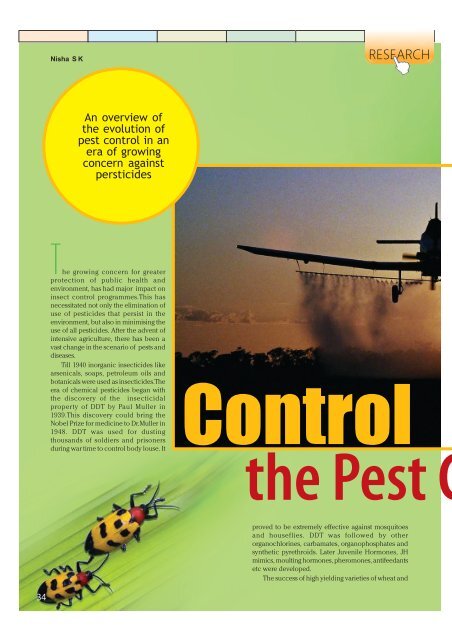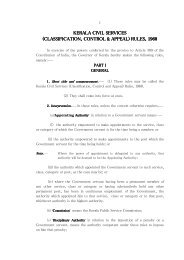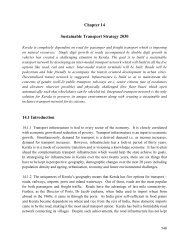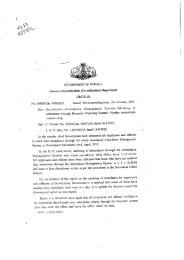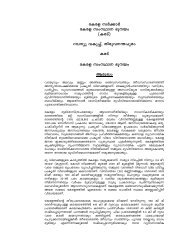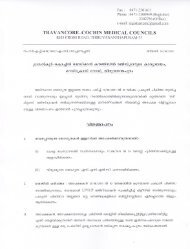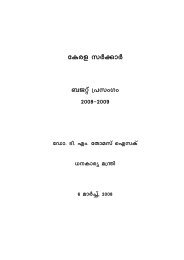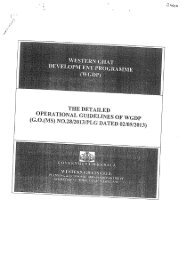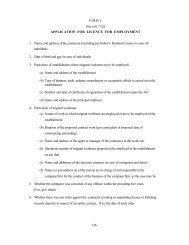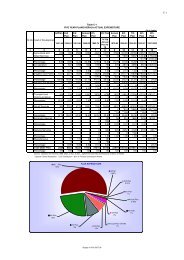est Control - Government of Kerala
est Control - Government of Kerala
est Control - Government of Kerala
You also want an ePaper? Increase the reach of your titles
YUMPU automatically turns print PDFs into web optimized ePapers that Google loves.
34 KERALA CALLING July 2011<br />
34<br />
Nisha S K<br />
An overview <strong>of</strong><br />
the evolution <strong>of</strong><br />
p<strong>est</strong> control in an<br />
era <strong>of</strong> growing<br />
concern against<br />
persticides<br />
The growing concern for greater<br />
protection <strong>of</strong> public health and<br />
environment, has had major impact on<br />
insect control programmes.This has<br />
necessitated not only the elimination <strong>of</strong><br />
use <strong>of</strong> p<strong>est</strong>icides that persist in the<br />
environment, but also in minimising the<br />
use <strong>of</strong> all p<strong>est</strong>icides. After the advent <strong>of</strong><br />
intensive agriculture, there has been a<br />
vast change in the scenario <strong>of</strong> p<strong>est</strong>s and<br />
diseases.<br />
Till 1940 inorganic insecticides like<br />
arsenicals, soaps, petroleum oils and<br />
botanicals were used as insecticides. The<br />
era <strong>of</strong> chemical p<strong>est</strong>icides began with<br />
the discovery <strong>of</strong> the insecticidal<br />
property <strong>of</strong> DDT by Paul Muller in<br />
1939.This discovery could bring the<br />
Nobel Prize for medicine to Dr. Muller in<br />
1948. DDT was used for dusting<br />
thousands <strong>of</strong> soldiers and prisoners<br />
during war time to control body louse. It<br />
RESEARCH<br />
<strong>Control</strong><br />
the P<strong>est</strong> C<br />
proved to be extremely effective against mosquitoes<br />
and houseflies. DDT was followed by other<br />
organochlorines, carbamates, organophosphates and<br />
synthetic pyrethroids. Later Juvenile Hormones, JH<br />
mimics, moulting hormones, pheromones, antifeedants<br />
etc were developed.<br />
The success <strong>of</strong> high yielding varieties <strong>of</strong> wheat and
<strong>Control</strong><br />
rice in Green Revolution was partially due to the<br />
protection umbrella <strong>of</strong> p<strong>est</strong>icides. The intensive<br />
and extensive use, misuse and abuse <strong>of</strong><br />
p<strong>est</strong>icides during the ensuing decades caused<br />
widespread damage to the environment.<br />
Usage Pattern<br />
Though Indian p<strong>est</strong>icide industry is the fourth<br />
The danger <strong>of</strong><br />
p<strong>est</strong>icides to bees<br />
comes not only<br />
from direct<br />
contact poisoning,<br />
but also from the<br />
taking pf poisoned<br />
nectar into hives.<br />
larg<strong>est</strong> in the world and second larg<strong>est</strong><br />
in Asia Pacific region, its share in global<br />
turnover is only 1.5-2 per cent. The Indian<br />
p<strong>est</strong>icide production industry started<br />
with the setting up <strong>of</strong> a BHC technical<br />
plant at Rishra near Kolkata in 1952. In<br />
India, the consumption <strong>of</strong> technical<br />
p<strong>est</strong>icide in agriculture has shown a fast<br />
increase from 432 tonnes during 1953-<br />
54 to 72130 tonnes in 1991-92. But<br />
in the recent past, change has<br />
been observed in the<br />
trends <strong>of</strong> p<strong>est</strong>icide<br />
consumption. Due<br />
to the adoption<br />
<strong>of</strong> bio<br />
intensive<br />
Integrated<br />
P e s t<br />
Management<br />
strategy in<br />
various<br />
crops the<br />
consumption<br />
<strong>of</strong> chemical<br />
p<strong>est</strong>icides has<br />
come down<br />
significantly.<br />
July 2011<br />
KERALA CALLING<br />
35
Consumption <strong>of</strong> p<strong>est</strong>icides in<br />
India<br />
Year Quantity<br />
( Thousand Tonnes)<br />
1994-95 61.36<br />
1999-00 46.20<br />
2004-05 40.67<br />
2008-09 43.86<br />
Source: Department <strong>of</strong> Agriculture and<br />
Co-operation, New Delhi<br />
P<strong>est</strong>icide consumption in India for<br />
agricultural purpose is 288 g/ha, while<br />
the global average is 900 g/ha. Andhra<br />
Pradesh and Punjab consume 47<br />
percent <strong>of</strong> total p<strong>est</strong>icides. Cotton<br />
consumes 45 per cent <strong>of</strong> p<strong>est</strong>icides used<br />
in the country followed by vegetables/<br />
fruits(13-24 per cent) and rice(20 per<br />
cent).<br />
The export <strong>of</strong> the p<strong>est</strong>icides have<br />
shown a growing trend. The export<br />
earning was Rs.2010 million in 1993-94,<br />
which rose to Rs. 10000 million in 1997-<br />
98 and 16000 million in 2000-2001.India<br />
exports synthetic Pyrethroid,<br />
Chlorpyriphos and few other p<strong>est</strong>icides.<br />
Resistance to Insecticides<br />
The occurrence <strong>of</strong> p<strong>est</strong>icide<br />
resistance in India was first noticed in<br />
insects <strong>of</strong> public health importance. Large<br />
amount <strong>of</strong> insecticides used under the<br />
National Malaria <strong>Control</strong> Programme<br />
from 1948 to 1960 resulted in the<br />
development <strong>of</strong> insecticide resistance in<br />
insect vectors <strong>of</strong> human diseases. In<br />
agriculture, development <strong>of</strong> resistance<br />
appeared comparatively later because<br />
appreciable amount <strong>of</strong> insecticide was<br />
used from 1970 onwards on agricultural<br />
crops raised using high yielding varieties,<br />
irrigation and fertiliser. Insecticide<br />
resistance occurs as a result <strong>of</strong><br />
inappropriate and largescale use <strong>of</strong><br />
p<strong>est</strong>icides particularly at sub lethal doses,<br />
repeated application <strong>of</strong> the same<br />
p<strong>est</strong>icide or similar group <strong>of</strong> p<strong>est</strong>icides<br />
over a period <strong>of</strong> time as well as under<br />
36 KERALA CALLING July 2011<br />
dosing due to substandard p<strong>est</strong>icidal<br />
formulations. The application <strong>of</strong><br />
p<strong>est</strong>icides may also bring resurgence <strong>of</strong><br />
target p<strong>est</strong>s against which the chemicals<br />
are applied and also lead to the outbreak<br />
<strong>of</strong> some p<strong>est</strong>s hitherto unimportant. The<br />
introduction <strong>of</strong> lindane to control the<br />
aphids as well as boll weevil led to<br />
outbreaks <strong>of</strong> mites due to d<strong>est</strong>ruction <strong>of</strong><br />
natural enemies.<br />
The modernisation <strong>of</strong> agriculture<br />
have directly or indirectly led to<br />
increased incidence <strong>of</strong> p<strong>est</strong>s and<br />
diseases. Monocropping, continuous<br />
cultivation <strong>of</strong> commercial crops,<br />
reduction in area <strong>of</strong> coarse cereals, minor<br />
millets etc. have raised many minor p<strong>est</strong>s<br />
to the level <strong>of</strong> major p<strong>est</strong>s. The number<br />
<strong>of</strong> insect p<strong>est</strong>s that were considered<br />
important in paddy cultivation increased<br />
from three in 1965 to more than 13 in<br />
1995.<br />
P<strong>est</strong>icide Residues<br />
P<strong>est</strong>icides are required during<br />
production, processing, storage and<br />
distribution<strong>of</strong> food. Thus food contains<br />
unavoidable residues <strong>of</strong> p<strong>est</strong>icides. Even<br />
in areas far away from the site <strong>of</strong><br />
application p<strong>est</strong>icide residues esp.,that<br />
<strong>of</strong> organochlorines have been found<br />
dominating. Similarly bioaccumulation<br />
<strong>of</strong> these chemicals in milk, butter, meat<br />
and even human fat has been observed.<br />
Studies revealed that 86 percent <strong>of</strong> soil<br />
samples collected from agricultural lands<br />
<strong>of</strong> Punjab were contaminated with DDT,<br />
HCH, endrin and lindane. Residues <strong>of</strong><br />
DDT have been detected in Yamuna and<br />
Ganga. In UK the presence <strong>of</strong> insecticides<br />
was reported in rain water. Snow from<br />
Arctic was found contaminated with<br />
insecticidal residue.<br />
Earlier it was generally assumed that<br />
dilution in environment was a<br />
satisfactory answer to p<strong>est</strong>icide pollution.<br />
Today it is known that organochlorine<br />
compounds can persist in soil and water<br />
for periods <strong>of</strong> years to decades and they<br />
can be biomagnified in the tissues <strong>of</strong><br />
invertibrates, fish, birds and mammals.<br />
The rate <strong>of</strong> disappearance <strong>of</strong> residues <strong>of</strong><br />
insecticides is expressed in terms <strong>of</strong> half<br />
life, which is the time required for half <strong>of</strong><br />
given quantity <strong>of</strong> material to dissipate.<br />
The half life <strong>of</strong> DDT is 3-10 years and that<br />
<strong>of</strong> heptachlor, lindane and dieldrin are<br />
7-12, 2 and 1-7 years respectively.<br />
The most economic insecticides<br />
have combined broad spectrum insect<br />
toxicity with extended persistence in the<br />
environment. This combination is now<br />
regarded as undesirable, and broad<br />
spectrum activity must be combined with<br />
limited persistence.<br />
The p<strong>est</strong>icides are also harmful to<br />
beneficial fauna such as honey bees and<br />
natural enemies like parasites and<br />
predators. The danger <strong>of</strong> p<strong>est</strong>icides to<br />
bees comes not only from direct contact<br />
poisoning, but also from the taking pf<br />
poisoned nectar into hives.
P<strong>est</strong>icide residues in several crops<br />
like tea, c<strong>of</strong>fee, spices, basmati rice etc<br />
have also affected our export <strong>of</strong> these<br />
commodities.<br />
Health hazards<br />
P<strong>est</strong>icides can interfere with a<br />
numbers <strong>of</strong> biological processes in<br />
humans. The outcome <strong>of</strong> such toxic<br />
interference can include sterility,<br />
decreased fertility, increased foetal deaths,<br />
increased birth defects, other<br />
reproductive problems etc.<br />
Studies revealed that occurrence <strong>of</strong><br />
cancer, kidney failure, still birth, infertility<br />
etc have been increased in Punjab. Cases<br />
<strong>of</strong> blindness, cancer, liver disease and<br />
p<strong>est</strong>icide poisoning have been reported<br />
from the cotton growing districts <strong>of</strong><br />
Maharashtra and Andhra Pradesh.<br />
Reports show that spraying <strong>of</strong><br />
endosulfan in the cashew plantations <strong>of</strong><br />
Kasargod since 1978, till 2001 created<br />
health disorders <strong>of</strong> very serious nature.<br />
Children were found to be worst<br />
affected with congenital anomalies,<br />
mental retardation, physical deformities,<br />
cerebral palsy, epilepsy, hydrocephalus<br />
etc. Men and women were also affected<br />
with various chronic ailments.<br />
Regulations<br />
The import, manufacture, sale,<br />
transport, distribution and use <strong>of</strong><br />
p<strong>est</strong>icides in India is being regulated<br />
under a comprehensive statute- The<br />
Insecticides Act,1968. A p<strong>est</strong>icide tragedy<br />
in <strong>Kerala</strong> that claimed several lives in<br />
1958 led to the enactment <strong>of</strong> this. Food<br />
containers were imported to Cochin Port<br />
along with lethal chemical Folidol. The<br />
p<strong>est</strong>icide leaked into the food materials<br />
during transport. Several people<br />
died after consuming food<br />
prepared from contaminated<br />
wheat flour.<br />
<strong>Government</strong> has banned<br />
the use <strong>of</strong> 30 p<strong>est</strong>icides,<br />
r<strong>est</strong>ricted the use <strong>of</strong> 13<br />
p<strong>est</strong>icides including DDT,<br />
refused registration for 18<br />
p<strong>est</strong>icides, allowed two<br />
p<strong>est</strong>icides for export and had<br />
banned import <strong>of</strong> four<br />
p<strong>est</strong>icides.<br />
In 2006, the use <strong>of</strong> endosulfan<br />
throughout <strong>Kerala</strong> was put on hold<br />
by Govt. <strong>of</strong> India. In April 2011 a global<br />
ban with a phase <strong>of</strong>f period was arrived<br />
at Stolkhom Convention. Now the<br />
Conference <strong>of</strong> the Parties to the Rotterdam<br />
Safe Alternatives<br />
Large number <strong>of</strong> natural products having biocidal<br />
activity have been discovered from plants, animals and<br />
microbial sources, but have been exploited only to a<br />
limited extent. Nicotine, rotenone, sabadilla, ryania and<br />
pyrethrum are the important botanical insecticides. Neem<br />
has shown selective activity against wide array <strong>of</strong> insects.<br />
Neem acts as a feeding deterrent, growth disruptor,<br />
repellant, ovipositional deterrent etc.<br />
Dr. Jayaprakash <strong>of</strong> Central Tuber Crop Research<br />
Institute has developed a biop<strong>est</strong>icide from cassava<br />
leaves. According to him it is very effective against borer<br />
p<strong>est</strong>s like red palm weevil <strong>of</strong> coconut and pseudostem<br />
borer <strong>of</strong> banana. A neem based insecticide against<br />
mealybug was also developed, spraying <strong>of</strong> which<br />
removes the waxy coating and exposes the p<strong>est</strong>.<br />
Convention, decided to list endosulfan<br />
under annex III. This makes Prior<br />
Informed Consent <strong>of</strong> importing countries<br />
necessary for export <strong>of</strong> the p<strong>est</strong>icide.<br />
Integrated Approach<br />
The combined impact <strong>of</strong> all<br />
problems <strong>of</strong> chemical p<strong>est</strong> control<br />
strategy led to the development <strong>of</strong> IPM<br />
concept. Integrated P<strong>est</strong> Management<br />
(IPM) refers to an ecological approach<br />
in p<strong>est</strong> management in which all<br />
available techniques are consolidated in<br />
a unified programme, so that p<strong>est</strong><br />
populations can be managed in such a<br />
manner that economic damage is<br />
avoided and adverse side effects are<br />
minimised. The United Nations<br />
Conference on Environment and<br />
Development(UNCED) assigned a<br />
pivotal role to IPM in the agricultural<br />
A p<strong>est</strong>icide tragedy<br />
in <strong>Kerala</strong> that claimed<br />
several lives in 1958<br />
led to the enactment<br />
<strong>of</strong> the Insecticides<br />
Act,1968. The import,<br />
manufacture, sale,<br />
transport, distribution<br />
and use <strong>of</strong> p<strong>est</strong>icides<br />
are regulated<br />
by this Act.<br />
programmes and policies. During the last<br />
three decades IPM has moved from a<br />
perepheral position to the centre stage<br />
<strong>of</strong> agricultural production programmes.<br />
Effort is to be made to keep insectide<br />
use to the minimum and to rely to the<br />
extend possible on biological control<br />
and improved cultural practices and<br />
other methods to prevent the build up<br />
<strong>of</strong> insect populations to levels that cause<br />
economic damage. The following excerpt<br />
from ‘Silent Spring’ reflects the need to<br />
control the use <strong>of</strong> harmful chemicals-<br />
“There is no safe dose for a carcinogen<br />
and, if there was, we would not know<br />
what it was. We are eating these chemicals,<br />
possibly in small, possibly in large<br />
quantities, and certainly they are being<br />
stored in our livers and our fat.”�<br />
The writer is Agricultural Officer, Farm<br />
Information Bureau, Thiruvananthapruam<br />
July 2011 KERALA CALLING<br />
37


